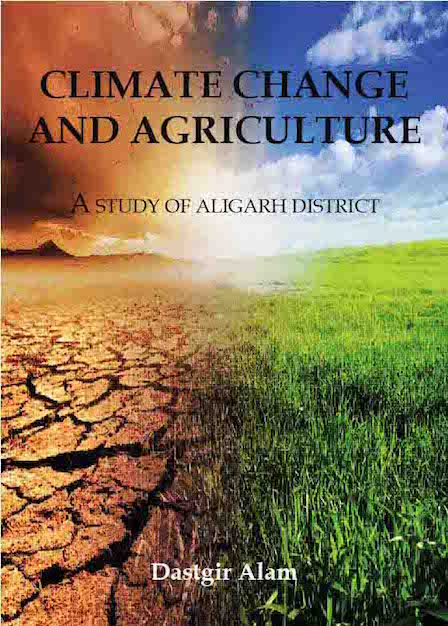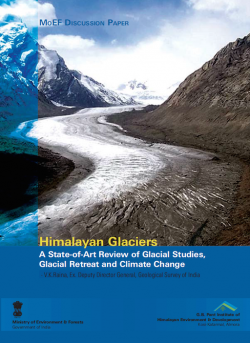Climate Change and Agriculture
The irrational resource utilisation for realising the rapid economic growth and development is the main cause of environmental degradation. The persistent environmental degradation for a longer period of time has led to the change in the weather/climatic conditions. Initially its effect was not so high that it can affect the human life. With the passage of time and increase in the degree of changes in climatic conditions it starts affecting the life of man-kind. Today these changes in climatic conditions have increased to a level that has brought extreme climatic events like hot waves, cold waves, cloud burst, heavy rainfall in very short period, flood, etc. These extreme events are closely related with disaster that causes damage to human life as well as destruction of resources. This necessitates the study of various dimensions related with the climate change and its effects on human civilisation.
Agriculture being the most sensitive sector to be affected by the climate change has always been a central problem associated with the climate change. The dependency between these two has been vigorously studied by many researchers at national and international level. Since the climatic conditions are largely governed by the environmental indicators (which are differently available at different places), as we move to localised analysis we approach to the proper informations related to climate change and its effects on agriculture. Because of this regional or local studies related to climate change and its effect on agriculture is more preferred than the general studies.
Keeping in mind this aspect of the study of climate change and its effect on agriculture sector, the present research project provides an insight into the developments caused by the climate change in the Aligarh District. The study is divided into five chapters. First chapter discusses about the problem of the present research work and gives the way to move on in understanding the relationship between the climate change and agriculture sector in Aligarh district. The climate profile of the district is presented in chapter 2 that shows a tendency of change in the climatic conditions in the district. With the help of regression analysis in the third chapter an attempt has been made to examine the effect of climate change on agriculture sector. The perception and observations of the farmers about the present research problem is given in the fourth chapter. Chapter five is devoted to the conclusion of the study and policy recommendations.
CONTENTS
Chapter I: Introduction
1.1 Introduction
1.2 The Demographic Features of the District
1.3 Climate of Aligarh District
1.4 Major Crops of the District
1.5 Review of Literature
1.5.1 International Status
1.5.2 National Status
1.6 Objectives of the Study
1.7 Hypothesis of the Study
1.8 Methodology of the Study
1.9 Significance of the Study
Chapter II: Climate Profile of Aligarh District
2.1 Introduction
2.2 Effects of High Temperature on Agriculture
2.3 Effects of Low Temperature on Agriculture
2.4 Pattern of Temperature in the District
2.5 Pattern of Relative Humidity in the District
2.6 Pattern of Rainfall in the District
Chapter III: Climate Change and Agriculture
3.1 Introduction
3.2 Climatic Conditions and Agricultural Productivity
3.3 Climate Change in the Kharif Season
3.3.1Changes in Temperature
3.3.2 Changes in Relative Humidity
3.3.3 Changes in Rainfall
3.4 Climate Change in Kharif Season and Agricultural Productivity
3.4.1 Climate Change and Productivity of Cotton
3.4.2 Climate Change and Productivity of Moong
3.4.3 Climate Change and Productivity of Soyabeen
3.4.4 Climate Change and Productivity of Sunflower
3.4.5 Climate Change and Productivity of Arhar
3.4.6 Climate Change and Productivity of Rice
3.4.7 Climate Change and Productivity of Bajra
3.5 Climate Change in the Rabi Season
3.5.1 Changes in Temperature
3.5.2 Changes in Relative Humidity
3.5.3 Changes in Rainfall
3.6 Climate Change in Rabi Season and Agricultural Productivity
3.7 Climate Change and Productivity of Rabi Crops
Chapter IV: Climate Change, Agriculture and its Implications for Rural Poor
4.1 Introduction
4.2 Khair Tahsil
4.3 Demographic Profile of Respondents
4.4 Changes in Temperature
4.5 Temperature and Agriculture
4.6 Frequency of Drought
4.7 Behaviour of Monsoon
4.8 Pattern of Rainfall
4.9 Behaviour of Winter Season
4.10 Incidence of Acidic Rain
4.11 Status of Deforestation
4.12 Status of Replantation
4.13 Problem of Drinking Water
4.14 Climate Change and Crop Failure
4.15 Climate Change and Implications for Rural Poor
Chapter V: Conclusions and Recommendations
5.1 Conclusions
5.2 Policy Recommendations


 are now available. As low
as ₹120.00 per month.
are now available. As low
as ₹120.00 per month.















